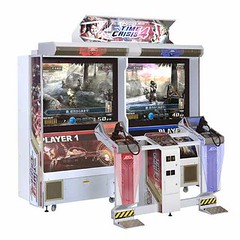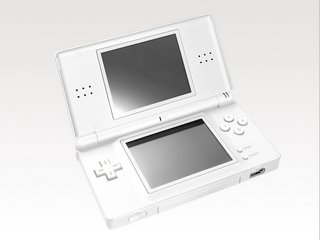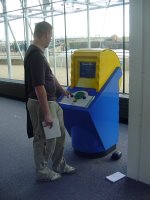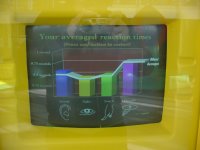User Centered Design
Re-Design of Nintendo DS Lite
IntroductionIn a previous module I looked at the Nintendo DS Lite handheld gaming console and discussed the products usability and HCI issues. I now intend to take an user-centred approach, to redesign and make an improved prototype of this product. This article concludes with an evaluation of my redesigned prototype using Nielsen’s Discounted Usability Engineering method (‘DUE’).
Stage One - RedesignTo help identify user needs and requirements, I conducted a focus group with several friends who own or have used a Nintendo DS, as well as some who had never used one before. I wished to observe how people used the system and also hoped to identify any problems people had when using it. Furthermore, I was keen to learn what people thought was positive about the device and what could be done to improve it’s usability.
Several user issues and observations were identified. Firstly some users had sensitivity issues with both the D-Pad and the Touch Screen, meaning the user had to press down much harder in some games than others. There are also reliability issues with it’s built in Microphone; this is apparent in such games where the user is asked to interact with the game by blowing into the Microphone.
Some users commented that the DS is not exactly ergonomic. The rectangular base is reminiscent of a slightly smoothed NES controller, meaning you cannot wrap your palms all the way around it. However, whether in use with the normal controls, stylus or the thumb strap nobody complained of the device being uncomfortable to use. Nobody experienced any hand cramps which often plague some owners of small handheld devices who use them for prolonged periods.
On the positive side, I received an overwhelmingly positive response with regards to the devices usability & interface. To test usability and to see how effective the interface is, I asked all my participants to perform a simple task; switching the device on > loading a game > playing the game > switching the device off. Users reported that all the buttons on the interface are clearly marked and there is not too many either, with no unnecessary buttons that could confuse the user. As for the devices interface and menus, they are laid out and presented extremely well. There are large icons, with not too many options and diagrams to help reassure the user they are selecting the correct option. (A run down of the main Menu screen is presented below).

Top screen1. Tool Bar - This displays the users name, the time on a 24 hour clock and the date.
2. Clock - Displaying the time.
3. Calendar - Displaying the date.
Bottom Touch Screen4. Game Option File - Select this to play if a game is inserted. When a game is inserted, It displays the games name in text and also has a relevant picture.
5. Pictochat - This option file is for instant chat software which allows DS owners to communicate with each other, much like MSN messenger or Yahoo messenger.
6. DS Download Play - This option allows DS owners to download game patches off other DS owners so they can play each other wirelessly.
7. Game Pak - This option becomes visible when a game pak is inserted.
8. Settings - This option allows the user to change the devices settings, e.g. time, date, brightness, user information.
One innovation that was discussed was whether the inclusion of an analogue stick would be appropriate. However, as I discovered with the DS lower touch screen, it has the potential to offer similar functions as an analogue controller, but with greater interaction. PC shooters for example have had the advantage of mouse look, which gave a whole new dimension of immersion. But with the DS, games like Metroid Prime Hunters brings mouse look control into your pocket. With the default controls, the action plays out on the top screen and you use the touch screen and stylus to look around, whilst the D-Pad move you around and the triggers fire. So tasks preformed with conventional analogue sticks can also be preformed with greater effect with the DS stylus or thumb stick on the touch screen.
I also conducted internet based research to determine what other problems Nintendo have had with the production of the DS console. Even though the overall opinions are positive, there has been one or two manufacturing issues. There has been problems with the outside casing, with cracks appearing on the hinge nearest the left shoulder button. This problem is purely cosmetic and does not affect the game play or console whatsoever. Other users have reported dead or stuck pixels, although this is pretty common amongst TFT screens.
By conducting user testing I have learned that many of the problems the DS has is with it’s hardware and issues that arise after the manufacturing process. As for usability, the device has a clearly defined menu which is simple to navigate. It is similar to a mobile phone menu and incorporates similar design traits. Seeing there are no clear problems with the ergonomics or usability of the device, I have decided to focus my redesign work on the aesthetical appeal of the DS. I had the intention of creating a product which would incorporate all the features of the original, but would bring something new to the table and could still be incorporated into the existing Nintendo DS products line.
After completing several rough sketches, the concept I came up with was that of an expandable device, with a flip top screen (shown below). Apart from incorporating the new features of the expandable design with a flip screen, this design has the advantage of being smaller than the DS Lite when it is not in use. Meaning it takes up less room on your person and when in storage. Something else I think could be an interesting concept would be light up buttons (e.g. Red LED buttons). This feature could then be used for such games where the user is required to press a button at a certain time (e.g. Dance games).
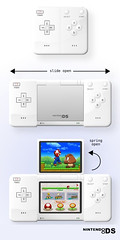
Stage Two - User Testing
For this stage I was required to evaluate my redesigned prototype using Nielsen’s Discounted Usability Engineering method (‘DUE’). A method of user testing was difficult to realise with my redesign. As I found the DS has excellent user interaction qualities, I am only concerned with testing the ergonomics and aesthetical appeal of my redesign. I decided against creating a High-fidelity 3D prototype, predominately because I was not changing the Devices interface. Furthermore, you navigate the menus and select options through the touch screen, so a visual representation on a computer could be considered too artificial. Other factors for this decision include the high costs that would be involved, lack of time and lack of software. For these reasons Instead I created two Low-fidelity prototypes by printing off an image of my redesign and placing it onto blue foam; one of the console closed & another with the flip screen open. This approach has the advantage of being very cheap and quick to create, although it does not give me as much or as accurate information as a high-fidelity prototype would.
To conduct the trial, I asked each individual in the focus group to hold first the original Nintendo DS Lite console and then my two redesigned blue foam models. I then asked them to simulate performing various actions, so I could discover if the device was comfortable to use and that all the buttons were in a practical place.
Results
As I made my redesign with the original DS Lite in mind, I incorporated many of the originals key characteristics. I believe it is because of this reason that I received overall positive feedback. Users reported that they found the device to be more practical because it fitted into their pockets easily. Because the button layout is similar to the originals, nobody could see any user interaction issues. Furthermore, as the device is the same size as the original when it is in use, users reported no problems with the ergonomics of the new design. However, It was pointed out that my blue foam models did not effectively show how the device opened or how the flip-screen operated.
Nielsen’s Discounted Usability Engineering method (‘DUE’)Simple and natural dialogueShort precise langue is used to not confuse the user.
Speak the users’ languageA wide age-range of people would use this device. For this reason it is important that language is kept simple and to a minimum.
Minimise the users’ memory loadThe amount of operations a user can perform are kept to a minimal, not to overburden the users memory load. This device is predominately used for playing games, one main menu screen means that options are kept to a minimum.
ConsistencyThe Language and Visuals used are consistent throughout the console. Information is presented in the same format and location throughout. This gives the users more confidence in using and exploring the system.
FeedbackLoading screens appear to reassure the user. They are never left in any doubt about the system state or what is happening. Fortunately the system does not have a long response time for the actions you ask it to perform, so in-depth user feedback is not needed.
Clearly marked exitsIf a user makes a mistake or accesses a option they did not intend, exit boxes are always situated on the top right of the screen. This is consistent with the layout on many computer programs.
ShortcutsFew shortcuts are provided because of the minimal operations you can perform on the device and because they are not needed in game play.
Good error messagesError messages are a rarity. When they do appear, they are in plain and clear language, avoiding the use of obscure codes or technical jargon which could confuse the user.
Help and documentationA short precise manual is provided that explains all the key operations effectively without overburdening the user.





